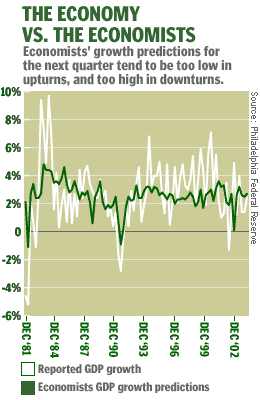NEW YORK (CNN/Money) -
The economy suddenly looks stronger than anyone thought.
Thanks to some big revisions to the government's retail sales reports and late-breaking news on foreign trade, second-quarter gross domestic product grew by more than the initially reported 2.4 percent.
What's more, economists up and down Wall Street have been lifting their views on the third quarter. Sales were strong in July -- surprisingly so, given that the effects of those tax rebate checks, which began hitting mailboxes late in the month, are still to come. Meantime, the gathering strength seen in the June durable goods report points to increased spending by businesses in the third quarter.

Goldman Sachs chief U.S. economist Bill Dudley says his forecast that the economy will grow at a 3 percent annual rate in the third quarter looks like it could be too low. Likewise, Merrill Lynch chief North American economist David Rosenberg says that his forecast for 3.5 percent growth could come up short -- 3.75 percent, or maybe even 4 percent, is more like it. And Morgan Stanley chief U.S. economist Richard Berner says growth may touch 5 percent rather than the 4.1 percent he's forecast.
And it may well be that when the third quarter GDP report finally does come out, it will still be better than what economists have lately been penciling in.
At least this will be the case if history is any guide. A look through economists' growth forecasts the Philadelphia Fed has been gathering since the early 1980s shows a tendency among the dismal scientists to underforecast growth when the economy is picking up and to overforecast it when the economy goes into decline.
As the country lifted out of the crushing recession that ended in late 1982, for instance, the economy bounced back like gangbusters, blowing past economists' expectations. In early 1983, to take an extreme example, economists expected second-quarter growth of 2.7 percent. It was reported at 9.4 percent.
In contrast, ever since the economy began to falter in 2000, economists have habitually expected growth to be stronger than what ended up being reported.
"They always tend to never expect it to decline as much as it actually does and never to increase as much as it does," said Don Fine, president of Fine Financial Forecasting.
How come? Fine thinks part of it is because most Wall Street economists aren't particularly fond of sticking their necks out, especially when the economy is shifting speeds. Even if you think that growth is going to be much stronger than what the consensus is estimating, you hesitate to share that, because the embarrassment of being too high is far greater than the embarrassment of being too low.
"The one thing you don't want to do is go from an estimate of 3 percent to 5 percent and back to 4 percent," said Fine. "So you baby step -- that's really what goes on."
There are a couple of other reasons economists tend to get it wrong when growth heats up, points out Aeltus Investment Management strategist Jim Griffin. First off, most of time the most accurate way to forecast growth is just to extrapolate from whichever way the trend in the economy has been going. But when the economy heads into a growth spurt, that tactic doesn't work.
Second, after first being surprised by the downturn in the economy, and then surprised by how long it's been mired, economists have probably developed a tendency toward conservatism.
"After three years of everything not working, you end up not quite trusting your models," said Griffin. "All of a sudden the tires get traction, and you start screeching down the road."

|

